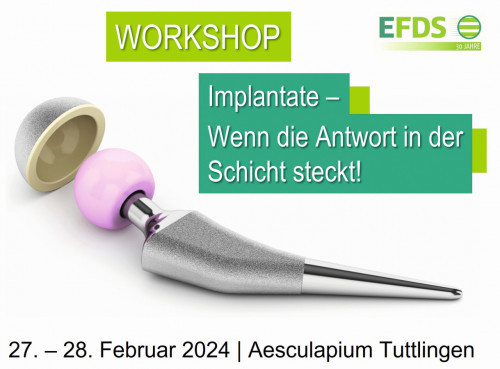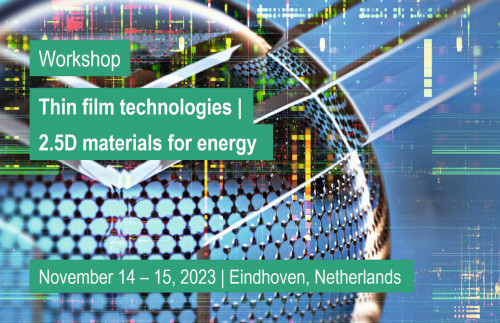The diversity of carbon in nature and in technically produced materials is matched by its wide range of applications. Modifications include the crystalline forms graphite, diamond and graphene as well as amorphous carbon (also known as diamond-like carbon, DLC). Thin carbon layers in the form of amorphous layers with high microhardness reduce friction and wear, e.g. in cutting tools, medical instruments, implants, industrial components such as pistons and gear wheels or watch components [1]. An overview of current projects and events of the European Research Society for Thin Films EFDS.
Carbon layers - fundamentally different structures for a wide range of applications
Compared to amorphous coatings, crystalline chemical vapor deposition (CVD) diamond coatings have a significantly higher hardness and wear resistance. Due to the high deposition temperatures, better adhesion to the substrates can be achieved. However, not all materials can be coated with diamond coatings, as the high process temperatures limit the range of materials that can be coated. However, current research results in this area also show how microstructured surfaces can open up new application potential for CVD diamond coating.
Graphene is another example of carbon modification. The special properties of the material, such as its extraordinarily high tensile strength, high modulus of elasticity and electrical properties, enable a wide range of applications, for example in energy technology.
The European Research Association for Thin Films - EFDS - e. V., based in Dresden, supports researchers and users in their current research and development in this field. The research topics are presented and discussed at relevant specialist events. These provide a very good overview of innovative developments and the state of the art. Experts and interested parties meet here to discuss their questions. Research topics are discussed in the EFDS technical committees and are then aligned for industry in projects of the Industrial Collective Research IGF. The results of the research are presented at international conferences such as V2023 (September 18-21) or PSE2024. Here, experts and users can exchange information on coating solutions, discuss opportunities and initiate new collaborations in an open atmosphere.
CVD diamond coatings on steel seal faces Current research from the EFDS Tribological Systems Technical Committee
Diamond coatings are characterized by very high hardness, wear and chemical resistance and their use is associated with low coefficients of friction. They differ from amorphous carbon coatings in many respects. The diamond coatings are produced, for example, by chemical vapor deposition (CVD) at temperatures of around 800 °C. Until now, it has not been possible to apply CVD diamond coatings to steel, as the iron in the steel promotes graphitic carbon deposition and the large difference in the coefficient of thermal expansion between steel and diamond leads to very strong residual cooling stresses and thus to coating delamination. In the research project "Adhesion-resistant CVD diamond coatings on steel seal faces", scientists from Chemnitz University of Technology and Friedrich-Alexander-Universität Erlangen-Nürnberg successfully deposited a 15 μm thick CVD diamond coating on a deterministically microstructured steel surface for the first time. The layer lasted over a wet running distance of 120 km at a nominal surface pressure of 6.4 MPa and a sliding friction coefficient of less than 0.01 (Fig. 1).
Sliding rings are used in plain bearings, e.g. for low-friction guidance of a shaft, or in mechanical seals. The latter are used to seal shaft bushings, for example in compressors. In axial plain bearings, the rotating seal ring is pressed against the stationary counter ring. This results in a mechanically highly stressed contact area between the two sliding surfaces of the seal face and the counter ring, which is crucial for the sealing effect. Components made of SiC, which are additionally coated with CVD diamond, are sometimes used in axial mechanical seals for particularly heavily loaded seal faces. This offers significant advantages, for example over steel components with a DLC coating that are also used in industry. However, SiC sliding rings are highly susceptible to breakage and very expensive. The focus is therefore shifting to CVD diamond coatings on steel.
The strong residual compressive stresses in the diamond layer that arise during the CVD diamond coating of steel during cooling could be reduced locally with microstructured surfaces generated by ultrasonic vibration-superimposed turning. In this way, it was possible to increase the adhesive strength between the substrate and the coating by specifically designing and generating the fine structure during the final machining of the functional surfaces.
In Germany, there are many SMEs that manufacture special seal rings for very different requirement regimes in individual production or in small quantities. This new technology is interesting for specialized industrial coating companies (mostly SMEs) on the one hand, and on the other hand for large companies that already deposit or use DLC coatings on steel components in quantities of millions. Furthermore, there are many SMEs that produce high-performance sliding rings, e.g. made of SiC, in smaller quantities and can therefore bring this new technology to the market [2].
DLC coatings in medical technology
Diamond-like carbon coatings are another form of carbon coating and are used in medical technology, for example. These coating systems are characterized in particular by their tribological and chemical properties and enable implants with long life cycles, biocompatible surfaces and the prevention of toxic components of the base material from escaping. The specific properties of the coating systems depend very much on the manufacturing technology and the coating conditions, which affect the structure of the resulting layers. DLC coatings have an amorphous structure characterized by a mixture of so-called sp1-, sp2- and sp3-hybridized carbon. The resulting properties also vary depending on the composition of the phases. Here, sp2 carbon centers promote a low wear coefficient and good electrical conductivity of the material, while sp3-hybridized atoms have a positive influence on chemical inertness, hardness and wear protection properties. Accordingly, the technology used to produce the coating is decisive for the resulting product [3, 4].
Furthermore, DLC coatings can be made multifunctional by doping with various elements with regard to industrially relevant properties. Silver and copper can be used to achieve an antibacterial effect against microorganisms [3]. Silicon can be used to improve the adhesion and thermal stability of coatings. Chromium and titanium increase corrosion resistance and reduce stresses in the coatings, which leads to stronger adhesion and greater durability of the coating [5].
DLC coatings are already commercially established in medical technology and are offered in different variants by various companies. Nevertheless, there are numerous approaches to further develop these coating systems.
 Fig. 2: Workshop "Implants - When the answer is in the coating" from February 27 - 28, 2024 in Tuttlingen
Fig. 2: Workshop "Implants - When the answer is in the coating" from February 27 - 28, 2024 in Tuttlingen
Graphene in microelectronics and energy technology
For decades, the trend in microelectronics and optoelectronics has been towards the miniaturization of structures, components and systems. This results in very high demands on the properties of the materials used and the process technology for the production of corresponding functional groups and their integration. Components must meet high standards of reliability and performance. Innovative manufacturing technologies are used to create energy-efficient and sustainable products with longer durability and resilience. New layer systems based on graphene and carbon nanotubes (CNTs) as well as material systems modified by doping are seen as a beacon of hope here [6]. New materials must be integrated into existing silicon-based systems. This poses numerous challenges in terms of the complexity of system integration technologies. They also require innovative processes and systems.
 Fig. 3: Workshop "Thin film technologies | 2.5D materials for energy" in Eindhoven from November 14 - 15, 2023
Fig. 3: Workshop "Thin film technologies | 2.5D materials for energy" in Eindhoven from November 14 - 15, 2023
One challenge lies in the integration of a large number of different components and the technological mastery of materials. This requires interdisciplinary cooperation between materials research, electronics research and equipment / system suppliers of thin-film technology in order to answer the following questions, for example: How can new materials as well as technologies be integrated into existing component concepts or process chains and what interactions occur with other process steps? Which deposition processes can be used for 2.5D materials and can they be scaled up for the manufacture of semiconductor products?
Literature
[1] D.K. Rajak; A. Kumar; B. Ajit; P.L. Menezes: Diamond-Like Carbon (DLC) Coatings: Classifications, Properties, and Applications, Appl. Sci, 11, 2021, 4445, https://doi.org/10.3390/app11104445
[2] Final report CVD diamond coatings on sliding rings made of steel, IGF project 20584 BG, project duration: 01.07.2019 - 31.12.2021
[3] M. Birkett; A.W. Zia; D.K. Devarajan et al: Multifunctional bioactive silver- and copper-doped diamond-like carbon coatings for medical implants, Acta Biomaterialia, https://doi.org/10.1016/j.actbio.2023.06.037
[4] K. Malisz; B. Swieczko-Zurek; A. Sionkowska: Preparation and Characterization of Diamond-like Carbon Coatings for Biomedical Applications - A Review, Materials, 16, 2023, 3420, https://doi.org/10.3390/ma16093420
[5] Q. Wang; F. Zhou; Z. Zhou; C. Wang; L.K.-Y. Li; S.-T. Lee: Effect of Titanium or Chromium Content on the Electrochemical Properties of Amorphous Carbon Coatings in Simulated Body Fluid, Electrochim. Acta, 112, 2013, 603-611
[6] A.R. Urade; I. Lahiri; K.S. Suresh: Graphene Properties, Synthesis and Applications: A Review, JOM, 75, 2023, 614-630, https://doi.org/10.1007/s11837-022-05505-8


